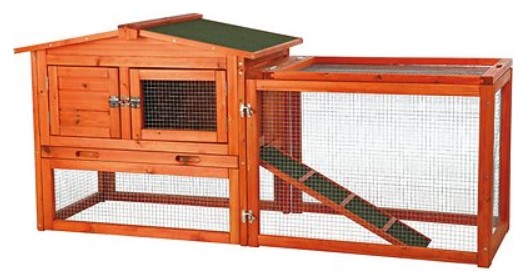Some authorities say you should never keep a rabbit outdoors; some say it’s okay for your rabbit to be outside during the day. Still others claim domesticated rabbits can be kept outdoors all of the time. You are your rabbit’s caregiver, so it is your decision.
If you are planning to keep your rabbit outdoors either part-time or full-time, it can benefit from fresh air, sunshine and the freedom to dig, burrow and more space to hop about. But, there are dangers to consider and preparations to make.
Some dangers of keeping a rabbit outdoors are:
- Predators – Rabbits are prey for coyotes, hawks, owls, dogs and even cats. Also, other wild animals such as raccoons may try to break into an out rabbit enclosure to eat the food. Rabbits have weak hearts and can die of fright on seeing or hearing a potential threat.
- Harmful vegetation – A rabbit outdoors loves to explore and may find plants that are poisonous to it. These include geranium, mushrooms, jasmine, avocado, lilies and iceberg lettuce. This is not an exhaustive list. For more information please visit Rabbit House Society’s PDF.
- Insects – Rabbits outdoors may be susceptible to fleas, flies and other pests. Flies can be especially dangerous as they may lay their eggs in a rabbit’s anal area. The hatching maggots will then burrow into the rabbit’s skin. This condition, called flystrike, is extremely dangerous and must be treated immediately.
- Disease – A rabbit outdoors is more susceptible to some diseases myxomatosis and viral hemorrhagic disease. These are spread by mosquitoes, flies, fleas and other infected rabbits.
- Weather – Temperatures too hot or too cold can be fatal to a rabbit outdoors.
Your Outdoor Rabbit Hutch
Your rabbit outdoors needs the proper accommodations. A spacious, multi-level outdoor rabbit hutch with a separate, enclosed sleeping area is the answer. Spacious means AT LEAST 12 square feet ideally linked to a much larger area (at least 32 square feet) for play and exercise. The minimum width should be 2 to 3 feet depending on the size of your rabbit. The length should allow your bunny to take 3 or 4 good hops without bumping into the wall of the hutch. It should be able to stretch out completely in all directions as well.
For Winter
 The hutch needs to be warm and dry. Adding legs helps to prevent damp and rotting wood. Cover any mesh openings with clear plastic to let in light while preventing drafts. But remember to keep some small areas open for ventilation. Turn the front opening away from the wind if possible. If not place a barrier between the wind and the hutch. Cover the top of the hutch with a blanket or carpet and cover that with a rainproof tarp to keep out wind and precipitation. Add extra bedding to the sleeping section for insulation.
The hutch needs to be warm and dry. Adding legs helps to prevent damp and rotting wood. Cover any mesh openings with clear plastic to let in light while preventing drafts. But remember to keep some small areas open for ventilation. Turn the front opening away from the wind if possible. If not place a barrier between the wind and the hutch. Cover the top of the hutch with a blanket or carpet and cover that with a rainproof tarp to keep out wind and precipitation. Add extra bedding to the sleeping section for insulation.
For Summer
Rabbits can deal with cold better than heat and temperatures rising above 85° F can easily cause heat stress in your outdoor rabbit. Locate your outdoor rabbit hutch in the shade or bring your bunny into the house during the hottest hours of the day. Place ceramic tiles on the floor of the hutch for your rabbit to lie on and stay cool. Plenty of crisp greens provide extra water and make sure your rabbit has plenty of fresh drinking water as well. You can put a fan near the hutch to circulate air, but don’t let it blow directly on your rabbit. And keep the cord out of reach! You can also build a homemade air conditioner and your bunny will love you for it. Again, keep the cord out of reach!
In conclusion, keeping a rabbit outdoors safely is an option given the right conditions. You must take all of the dangers into consideration and determine what is best for you and your rabbit. Remember that rabbits are social creatures and you should try to spend time with your bunny every day whether you keep it indoors or out.

